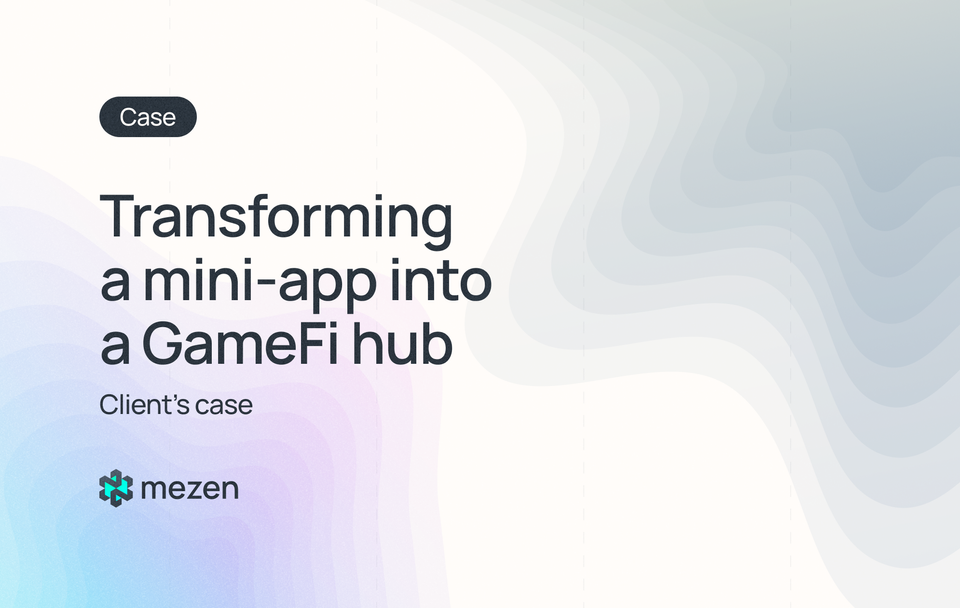Case study: Transforming a mini-app into a GameFi hub

Web3 projects face unique challenges when evolving from simple applications to comprehensive GameFi platforms. In this case study, we explore how a project with a massive online following successfully transitioned from a Telegram mini-app into a fully-fledged GameFi hub. The transformation highlights the power of strategic planning, robust tokenomics, and sustainable monetization strategies. With a user-centric approach and reliable execution, long-term success in the GameFi space becomes attainable.
Client overview
Our client had built an impressive online presence, with 8 million followers on their Telegram channel and 2 million monthly active users in the mini-app. However, the mini-app format was temporary. The vision was clear: transform into a comprehensive GameFi hub offering diverse gaming experiences. Turning this vision into reality required overcoming strategic and operational challenges typical of Web3 and GameFi development.
Challenges faced
The transition from a mini-app to a GameFi hub involved several interconnected challenges:
- Lack of a clear roadmap: The team needed achievable milestones that aligned with community interests.
- Web2 to Web3 transition: Integrating Web2 users into a Web3 ecosystem without alienation was essential to retain the user base.
- Monetization strategy: The absence of a defined monetization model raised concerns about long-term sustainability.
- Tokenomics clarity: The token's role and value within the platform needed a clear definition.
- Community trust: Concerns about potential airdrops threatened user trust, despite transparent communication efforts.
Objectives
Our primary objectives were to:
- Define key markets and analyze competitor landscapes.
- Pinpoint user needs that the platform could address.
- Design a sustainable monetization model.
- Map user journeys for seamless Web2 to Web3 transitions.
- Develop comprehensive tokenomics supporting growth goals.
Approach
Understanding the market
Through in-depth market research, we identified regions and segments where the GameFi hub could thrive. Estimating market share potential based on user demographics allowed us to tailor the product strategy effectively. This research highlighted emerging trends in GameFi, informing product development priorities and aligning with trending topics.
Refining the competitive edge
A detailed analysis of over 15 competitors revealed market gaps and potential unique selling propositions. These insights shaped the product roadmap and ensured differentiation in a crowded GameFi market. We focused on addressing user needs that existing solutions failed to meet.
Aligning with audience motivations
GameFi audiences are diverse:
- Competitive players: Attracted to high-stakes gameplay and betting opportunities.
- Casual gamers: Prefer immersive, story-rich single-player experiences.
- Community-driven players: Value social interaction and cooperative gameplay.
Understanding these preferences allowed us to tailor offerings that kept users engaged without overwhelming them with unnecessary features.
Crafting a sustainable monetization model
The monetization strategy combined short-term revenue opportunities with long-term growth. Competitive modes allowed users to place bets, appealing to competitive players. Immersive, story-driven single-player games engaged casual gamers. Additionally, a gradual Web3 integration ensured that Web2 users could adapt seamlessly, reducing friction and broadening the user base.
Building robust tokenomics
Our tokenomics model balanced user incentives, token value stability, and long-term ecosystem sustainability:
- Transparent airdrop strategies: Open communication built and maintained community trust.
- Utility tokens: Provided access to essential platform features, fostering ongoing user engagement and supporting the ecosystem.
Providing transparency through a whitepaper
To ensure clarity for both users and investors, we developed a comprehensive whitepaper. It outlined marketing strategies, detailed technical specifications designed for scalability, and presented long-term growth plans grounded in data-driven projections. This transparent approach reinforced the project's reputation as a reliable player in the GameFi sector.
Results achieved
Our collaborative approach delivered significant milestones:
- Diverse product roadmap: Included a competitive game inspired by Agar.io, where users could place bets and compete for prizes.
- High retention rates: Tailoring games based on audience segmentation proved effective in maintaining user engagement.
- Smooth Web2 to Web3 transition: Optimized user pathways ensured minimal onboarding friction.
- Restored community confidence: Transparent communication about the airdrop process strengthened community loyalty.
- Sustainable growth: The robust tokenomics model integrated utility tokens that unlocked essential platform features, ensuring long-term value creation.
Conclusion
This case study highlights the importance of strategic planning and a user-centric approach in Web3 transformations. Understanding audience needs, developing sustainable tokenomics, and maintaining transparent communication is essential to long-term success.
Are you building the next big thing in GameFi? Let Mezen help you get there. Our tailored strategies are designed to unlock sustainable growth and give your project a competitive edge in the Web3 ecosystem. Let’s connect and make it happen.

Comments ()